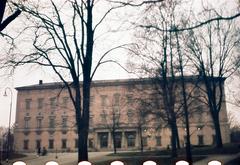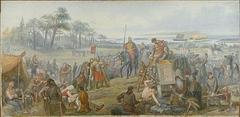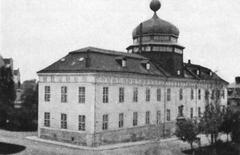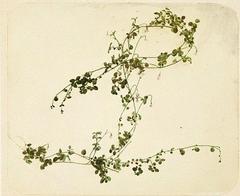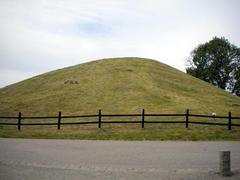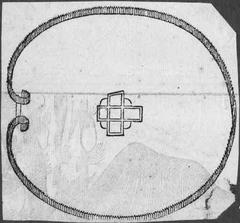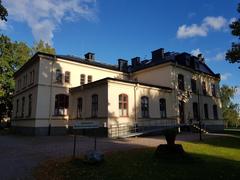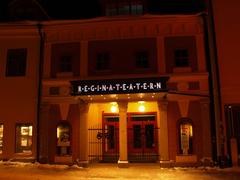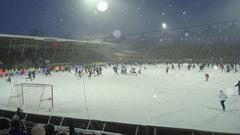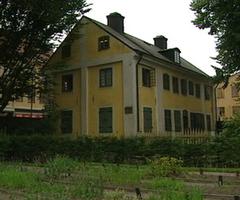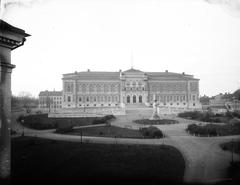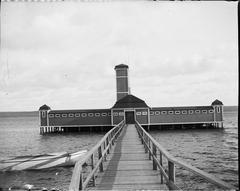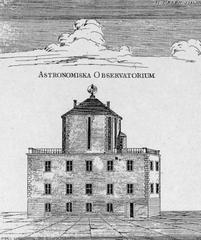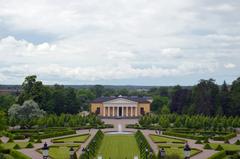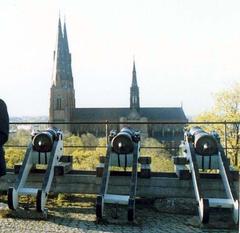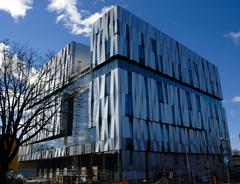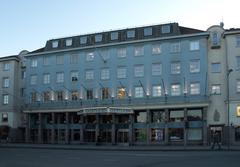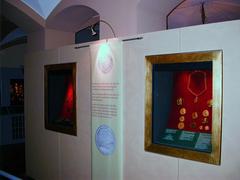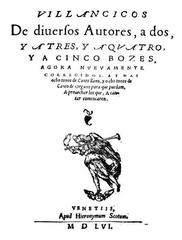Håga Kurgan Visiting Hours, Tickets, and Guide to Uppsala’s Historical Sites
Date: 15/06/2025
Introduction: Unveiling Håga Kurgan’s Legacy
Just west of Uppsala, Sweden, Håga Kurgan—also known as Hågahögen or King Björn’s Mound—stands as a monumental legacy of the Nordic Bronze Age. Erected around 1000 BCE, this burial mound testifies to the sophisticated social structures, ritual practices, and far-reaching cultural connections of the Mälar Valley’s ancient inhabitants. Rising nearly 7 meters high and stretching about 50 meters in diameter, Håga Kurgan is distinguished by its rich archaeological finds, including cremated remains of a high-status chieftain, gold and bronze artifacts, and traces of complex ceremonies. The site provides a rare, tangible link to Sweden’s prehistoric past and remains a cornerstone for understanding the region’s early development (Heritage Daily; Living Nomads).
Nestled within the scenic Hågadalen-Nåsten Nature Reserve, Håga Kurgan offers a unique blend of archaeological intrigue and natural beauty. The site is free to visit, accessible year-round during daylight hours, and features interpretive signage and maintained trails. Its proximity to other significant sites—including Gamla Uppsala and Uppsala Cathedral—makes it an essential stop for those exploring Sweden’s rich historical tapestry (Destination Uppsala; Ecksplorer).
This comprehensive guide details the history, archaeological highlights, practical visitor information, accessibility, nearby attractions, and tips for making the most of your Håga Kurgan visit.
Contents
- Historical Background
- Origins and Construction
- Ritual and Social Significance
- Mälar Valley and Scandinavian Bronze Age Context
- Archaeological Excavations and Discoveries
- Visitor Information
- Location and Access
- Visiting Hours and Tickets
- Accessibility
- Guided Tours and Events
- Visitor Tips
- Nearby Attractions
- Cultural and Mythological Legacy
- Frequently Asked Questions (FAQs)
- Visual and Interactive Resources
- Plan Your Visit
Historical Background
Origins and Construction
Håga Kurgan was constructed around 1000 BCE during the Nordic Bronze Age. The mound’s impressive size—7 meters tall and 45–50 meters in diameter—reflects the power and organizational capacity of the society that built it. Strategically located on a headland overlooking ancient routes, Håga Kurgan likely served as a focal point for trade and ritual in the Mälar Valley (Heritage Daily).
Ritual and Social Significance
The site functioned as more than a burial place; archaeological evidence points to ritual activities, including human sacrifice and ceremonial feasting. Cultic enclosures and secondary graves suggest ongoing veneration and use of the site long after the original burial.
Cultural Context in the Mälar Valley
Part of a broader complex that included settlements and defensive structures like the Predikstolen hillfort, Håga Kurgan was central to networks of exchange and power in Bronze Age Scandinavia.
Archaeological Excavations and Discoveries
Excavation History
The first major excavation (1902–1903), led by Oscar Almgren, revealed a timber burial chamber containing cremated remains, gold diadems, bronze weapons, and imported goods. Almgren’s meticulous stratigraphic methods set a standard in Swedish archaeology. Later research has identified evidence of early iron production in the area, further attesting to the region’s significance.
Grave Goods
Key finds include:
- Gold artifacts: A large neck ring (torc), spirals, and wire—one of Sweden’s largest Bronze Age gold hoards.
- Bronze weapons and tools: Swords, axes, razors.
- Ceramic vessels and amber beads: Indicating extensive trade.
These discoveries underscore the chieftain’s status and the region’s connections with distant cultures (Living Nomads).
Visiting Håga Kurgan: Practical Information
Location and Access
- Address: About 3 km west of Uppsala city center.
- Getting There: Easily reached by car, bicycle, or public transport. Buses #2 or #30 from Uppsala Central Station stop near the reserve entrance. There is ample parking at reserve edges (ambereverywhere.com).
Visiting Hours and Tickets
- Hours: Open year-round from dawn to dusk (outdoor site).
- Tickets: Free admission; no tickets required.
- Guided Tours: Available seasonally; book through local tourism offices or online platforms (destinationuppsala.se).
Accessibility
- Main trails are flat and suitable for wheelchairs and strollers; some side paths and the area around the mound are uneven.
- For detailed accessibility information, consult Uppsala.se.
Site Experience and Interpretation
Interpretive Resources
- On-site signage (Swedish and English) explains the mound’s history and archaeological significance.
- No visitor center at the mound, but many finds are displayed at the Swedish History Museum (Stockholm) and Gustavianum (Uppsala University).
Trails and Nature
- The Hågadalen-Nåsten Nature Reserve features open meadows, woodlands, and a small river. Trails are well-marked and suitable for all fitness levels.
- The reserve is rich in wildlife and seasonal flora—ideal for birdwatching and photography.
Amenities
- Picnic areas available; no restrooms or cafés at the site itself. Facilities are found at reserve entrances or in nearby neighborhoods.
Nearby Attractions
- Gamla Uppsala: Home to royal mounds and the Gamla Uppsala Museum.
- Uppsala Cathedral: Sweden’s largest church, located in the city center.
- Predikstolen Hillfort: Ancient fortification near Håga.
- Uppsala Castle: Renaissance-era castle with panoramic views.
Cultural and Mythological Legacy
Håga Kurgan is entwined with local legend, especially the saga of King Björn. It remains a symbol of Sweden’s ancient heritage, inspiring ongoing archaeological research and community events.
Educational Opportunities
- Self-guided walks: Marked trails and educational panels.
- School and university visits: Håga Kurgan serves as a key site for history and archaeology curricula.
- Museum links: Artifacts from Håga Kurgan can be explored further at the Swedish History Museum and Uppsala University’s Gustavianum.
Events and Seasonal Highlights
- Uppsala’s summer calendar features festivals, historical reenactments, and guided walks, especially at nearby Gamla Uppsala (destinationuppsala.se).
- The reserve is popular for berry and mushroom picking in season.
Visitor Tips
- Wear comfortable walking shoes.
- Bring water, snacks, and weather-appropriate clothing.
- Dogs are allowed on leash.
- Stay on marked paths and do not climb the mound.
- Early mornings and late afternoons offer the best light for photography.
Frequently Asked Questions (FAQs)
Q: What are Håga Kurgan’s opening hours?
A: The site is open daily, year-round, during daylight hours.
Q: Is there an entrance fee?
A: No, admission is free.
Q: Are guided tours available?
A: Yes, especially in summer. Book through local tourism offices.
Q: Is the site accessible for wheelchairs?
A: Main trails are accessible, though some areas are uneven.
Q: Can I climb the mound?
A: No, to preserve the site, climbing is not permitted.
Q: Are dogs allowed?
A: Yes, but must be leashed.
Visual and Interactive Resources
- Interactive maps and virtual tours available on local tourism websites.
- Images: “Håga Kurgan Bronze Age burial mound in Uppsala.”
- Downloadable audio guides via the Audiala app.
Plan Your Visit
- For up-to-date visitor information, see Destination Uppsala.
- Download the Audiala app for self-guided audio tours and exclusive content.
- Combine your trip with visits to Gamla Uppsala, Uppsala Cathedral, and the city’s museums for a comprehensive historical experience.
Summary and Recommendations
Håga Kurgan stands as a testament to Sweden’s Bronze Age past—an archaeological and cultural landmark offering insight into ancient rituals, social hierarchies, and regional connections. Its well-preserved mound, scenic setting, and accessibility make it a rewarding destination for history enthusiasts and nature lovers alike. Plan your visit during daylight hours, respect the site’s preservation rules, and enhance your experience with guided tours or digital resources. Pair your Håga Kurgan outing with other Uppsala attractions for a full immersion in the region’s remarkable history (Living Nomads; Destination Uppsala).
Sources and Further Reading
- New Light Cast on Scandinavia’s Most Important Bronze Age Site, 2018, Heritage Daily
- What to Do in Uppsala, 2021, Living Nomads
- Visit Håga Kurgan, Destination Uppsala
- Uppsala: The Hidden Gem Just North of Stockholm That’s Worth a Visit, Ecksplorer
- Uppsala Municipality Official Website
- Amber Everywhere: What to See in Uppsala
- Archaeology.org: Sweden, Gamla Uppsala
